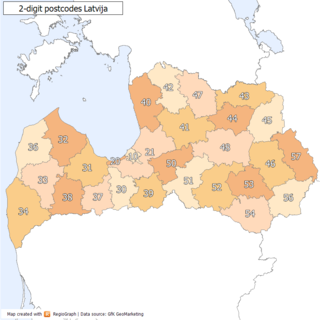
Postal codes in Lithuania since 2005 are 5 digit numeric, ISO 3166-1 alpha-2 prefix is allowed, with that the format is LT-NNNNN.
Previous to 2005 it was NNNN, which was the old Soviet NNNNNN format with the first 2 digits (23) dropped.

Postal codes in Lithuania since 2005 are 5 digit numeric, ISO 3166-1 alpha-2 prefix is allowed, with that the format is LT-NNNNN.
Previous to 2005 it was NNNN, which was the old Soviet NNNNNN format with the first 2 digits (23) dropped.
ISO 3166 is a standard published by the International Organization for Standardization (ISO) that defines codes for the names of countries, dependent territories, special areas of geographical interest, and their principal subdivisions. The standard employs a code of letters and numbers to represent the name of a given geographical area in order to save time and energy when describing the area, as well as to reduce the risk of description errors. The official name of the standard is Codes for the representation of names of countries and their subdivisions.

A postal code is a series of letters or digits or both, sometimes including spaces or punctuation, included in a postal address for the purpose of sorting mail.
ISO 3166-2 is part of the ISO 3166 standard published by the International Organization for Standardization (ISO), and defines codes for identifying the principal subdivisions of all countries coded in ISO 3166-1. The official name of the standard is Codes for the representation of names of countries and their subdivisions – Part 2: Country subdivision code. It was first published in 1998.

ISO 3166-1 alpha-2 codes are two-letter country codes defined in ISO 3166-1, part of the ISO 3166 standard published by the International Organization for Standardization (ISO), to represent countries, dependent territories, and special areas of geographical interest. They are the most widely used of the country codes published by ISO, and are used most prominently for the Internet's country code top-level domains. They are also used as country identifiers extending the postal code when appropriate within the international postal system for paper mail, and have replaced the previous one consisting one-letter codes. They were first included as part of the ISO 3166 standard in its first edition in 1974.
ISO 3166-2:KH is the entry for Cambodia in ISO 3166-2, part of the ISO 3166 standard published by the International Organization for Standardization (ISO), which defines codes for the names of the principal subdivisions of all countries coded in ISO 3166-1.
ISO 3166-2:FR is the entry for France in ISO 3166-2, part of the ISO 3166 standard published by the International Organization for Standardization (ISO), which defines codes for the names of the principal subdivisions of all countries coded in ISO 3166-1.
ISO 3166-2:TR is the entry for Turkey in ISO 3166-2, part of the ISO 3166 standard published by the International Organization for Standardization (ISO), which defines codes for the names of the principal subdivisions of all countries coded in ISO 3166-1.

MaxiCode is a public domain, machine-readable symbol system originally created by the United Parcel Service (UPS) in 1992. Suitable for tracking and managing the shipment of packages, it resembles an Aztec Code or QR code, but uses dots arranged in a hexagonal grid instead of square grid. MaxiCode has been standardised under ISO/IEC 16023.
Postal codes in Argentina are called códigos postales. Until 1998 Argentina employed a four-digit postal code for each municipality, with the first digit representing a region in the country, except in the case of the city of Buenos Aires. The unique codes became the base for the newer system, officially called CPA.

Postal codes in Turkey consist of five digits starting with the two digit license plate code of the provinces followed by three digits to specify the location within the districts of the province.
ISO 3166-2:LT is the entry for Lithuania in ISO 3166-2, part of the ISO 3166 standard published by the International Organization for Standardization (ISO), which defines codes for the names of the principal subdivisions of all countries coded in ISO 3166-1.
In the NUTS codes of Lithuania (LT), the three levels are:

Postal codes in the Czech Republic are called PSČ. The acronym is commonly pronounced as a word, rather than separate letters. The system was introduced in former Czechoslovakia in 1973 and has remained unchanged. The postal code consists of five digits, usually written with a space in the form XXX XX. The first digit indicates a region :

Postal codes in Hungary are four digit numeric. The first digit is for the postal region, as listed below :

Russian Post has a system of postal codes based on the federal subject a place is located in. Each postal code consists of six digits with first three referring to the federal subject or the administrative division with special status. Some larger subjects have multiple three-digit prefixes. For instance, Moscow's postal codes fall in the range 101–129.

Postal codes in Latvia are 4 digit numeric and use a mandatory ISO 3166-1 alpha-2 country code (LV) in front, i.e. the format is “LV-NNNN”.
There are currently 304 postal codes in Jamaica, with one and two-digit sector codes only being used in Kingston, the country's capital.

Postal codes in Azerbaijan consist of four digits.